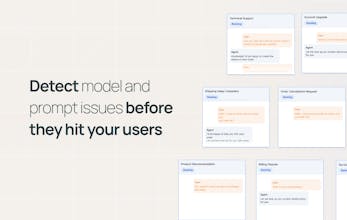
LangWatch Agent Simulations
Agentic testing for agentic codebases
5.0•10 reviews•1.1K followers
Agentic testing for agentic codebases
5.0•10 reviews•1.1K followers

1.1K followers
1.1K followers





Launched on June 26th, 2025

Launched on December 19th, 2024
LangWatch Agent Simulations is highly praised for its transformative impact on AI testing. Users appreciate its open-source nature and focus on agentic testing, which enhances confidence in deploying autonomous agents. The platform's robust simulations, intuitive API, and visualization tools streamline the testing process, while community support and regular updates reflect a commitment to improvement. Users find it valuable for output monitoring, evaluation, and production optimization, with features like jailbreak detection and document tracking. Overall, it's considered essential for serious AI development and quality assurance.

